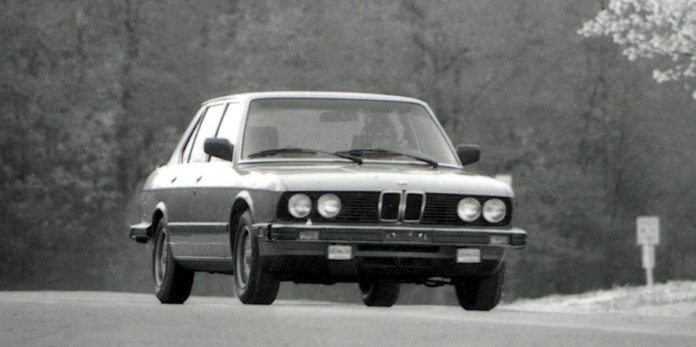From the August 1985 issue of Car and Driver.
There are two kinds of timing in the car business. The first is the timing that’s set when the tuneup guy strobes your engine to make sure the ignition is firing at the proper instant. The second is determined strictly by whether a revolutionary new model is fired into the showrooms at the proper moment. For BMW, the 524td is revolutionary simply because it is diesel-powered, albeit boosted with a turbocharger. The Bavarian Motor Works hopes the turbo will keep the 524td from clipping the wings of its reputation for performance.
However, just as regular timing lights are useless for tuning diesels, enthusiasts may wonder if the corporate timing light that BMW uses to calibrate its marketing strategy is on the fritz. With the glut of fuels, the cost of diesel, and the blitz of hot cars, diesel power has fallen from favor.
Diesels were once taboo with BMW, but a few years ago, when fuel was tight, the Bavarians put Austria’s Steyr-Daimler-Puch to work on designing an oil burner. In the early Eighties, Ford was also anxious to have a turbo-diesel option, so it arranged to buy such engines from BMW. Lincoln, however, has now canceled the Mark VII’s BMW-diesel option.
As oil burners go, BMW’s is a winner. Based on the M20 six-cylinder gas engine developed for the 528e and the 325e, it has been reengineered and designated M21D24. Its camshaft remains overhead, its head remains aluminum, its block remains cast iron, and BMW still favors a crossflow intake-exhaust tract for a good mix of performance, economy, and drivability. But durability needs dictated the full water-jacketing of all cylinders, which in turn required a 4 mm decrease in bore, to 80 mm. Other changes to the resulting 2443-cc powerplant include a higher percentage of chrome in the block for reduced wear; three reinforcing ribs cast laterally in the block; pistons lubricated by oil spray; more wear-resistant main bearings; reinforced main-bearing supports; stronger connecting rods and rod bearings; a forged-steel rather than cast-iron crankshaft; and, in the oil system, a doubling of pump capacity. The high (22.0:1) compression ratio requires a vertical valve arrangement rather than the inclined layout of BMW’s gas engines, and Nimonic alloy is used on extra-large valve seats. The camshaft lobes are nitrided, and the shaft itself turns in seven bearings instead of four.
Add-on sound-deadening measures include a 10 mm panel of Escan fiberglass formed to leave a small, acoustically desirable air gap on the underside of the hood; polyurethane foam across the outer firewall; added insulation on the passenger side of the firewall; better sealing of passages to the interior; and redesigned mounts and dampers for the entire drivetrain.
BMW says these changes and others add 140 pounds in comparison with the 528e. If the diesel program has deposited potatoes on the front wheels, BMW has offset them with meat in the engine. Early 524tds and 49-state Lincolns alike used a variety of mechanical devices to instruct engine functions now controlled by BMW’s latest round of computerization (also applied to California-spec Lincolns). Fuel-injection timing is electronically controlled and determined by flywheel position. Although conventional diesel injection takes its cues from the accelerator pedal, a BMW feedback loop also bases decisions on engine rpm, intake-manifold pressure, and coolant, fuel, and intake-air temperatures. An AiResearch T3 turbo pumps a maximum of 11.6 psi; then a flap valve relieves excess boost. Tuned exhaust pulses also help keep the 130,000-rpm turbo spinning.
The rated output is 114 horsepower at 4800 rpm, and it’s useful output, whipping up an 11.7-second 0-to-60-mph time and a top speed of 107 mph. The four-speed ZF automatic is well tailored to the power curve. The EPA rates the 524td at 24 mpg, and we couldn’t drag its C/D average below 22 mpg.
In tuning the 524td’s chassis, BMW has perhaps skimped on the basics. Its tires, though 195/70HR-14s, are of Michelin’s slim, long-life variety. General driving feel and coordination are quite good, and the car is a sweetheart on the highway, but skidpad laps and brake testing from 70 to 0 mph reveal a modest 0.72-g cornering limit and 219-foot stops, figures in the range BMWs turned in ten years ago.
Except for that, the 524td is easily a 90th-percentile car, full of power-assisted luxuries, deluxe comforts, and good manners. The work lavished on the turbo-diesel engine qualifies it as a worthy power source for a sports sedan. That said, there are at least two things to consider. First, are you ready to search out diesel fuel in unfamiliar territory in the middle of the night? Second, do you want to be ready the next time fuel becomes difficult to find in your own neighborhood even in the daytime? If the crunch comes again, the 524td could become the hot rod of a new age, in which case BMW had better figure on importing a lot more than the 2500 turbo-diesels it’s scheduled this year.
Specifications
Specifications
1985 BMW 524td
Vehicle Type: front-engine, rear-wheel-drive, 5-passenger, 4-door sedan
PRICE
Base/As Tested: $24,115/$24,955
ENGINE
turbocharged diesel inline-6, iron block and aluminum head
Displacement: 149 in3, 2443 cm3
Power: 114 hp @ 4800 rpm
TRANSMISSION
4-speed automatic
DIMENSIONS
Wheelbase: 103.3 in
Length: 189.0 in
Curb Weight: 3268 lb
C/D TEST RESULTS
60 mph: 11.7 sec
1/4-Mile: 18.2 sec @ 75 mph
100 mph: 45.6 sec
Top Speed: 107 mph
Braking, 70–0 mph: 219 ft
Roadholding, 300-ft Skidpad: 0.72 g
C/D FUEL ECONOMY
Observed: 22 mpg
EPA FUEL ECONOMY
City: 24 mpg
C/D TESTING EXPLAINED

